PSYC30 Lecture 3: Personality & Self-Knowledge
1/37
There's no tags or description
Looks like no tags are added yet.
Name | Mastery | Learn | Test | Matching | Spaced |
|---|
No study sessions yet.
38 Terms
how did the behaviourist’s and psychoanalyst’s belief on our capacity for self-insight differ?
behaviourist: dismissive of our capacity for self-insight
i.e., don’t ask self-report at all
psychoanalyst: most of personality lies beneath the surface of consciousness
i.e., listen to self-report, but believes it’s inaccurate
why is it important to personality psychology that we question the validity of self-knowledge?
a lot of the field relies on self-report (70% in JRP in 2006; Vazire, 2006) , assuming that we know the self more than others know us
if self-reports are unreliable, much of what we know about personality is also unreliable
Dunning-Kruger effect
the fact that we often overestimate our abilities
who is most susceptible to the Dunning-Kruger effect?
those with the least ability because they don’t know that they have a lot of knowledge gaps
those with moderate expertise tend to be more humble because they know their knowledge gaps
experts often don’t recognize that others don’t have the same knowledge as them
how might cognitive biases influence our self-view?
they change how we see ourselves, sometimes making us unaware different elements of ourselves
these biases may sometime make others aware of things about the self that we are unaware of
the Johari Window
a popular self-help tool to help people decipher which aspects of their identity is know/unknown to them and others
someone picks a number of adjectives from a list, choosing ones they feel describe their own personality
subject's peers then get the same list, and each picks an equal number of adjectives that describe the subject
adjectives are then inserted into a two-by-two grid of four cells.
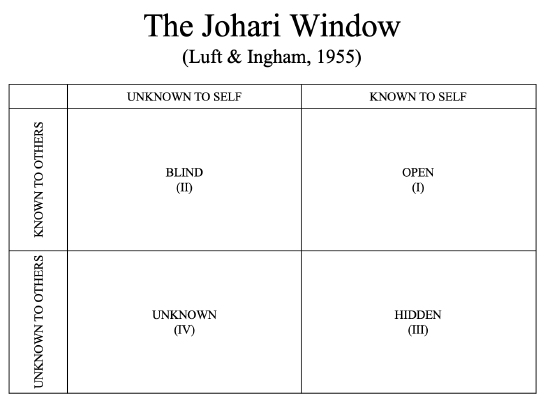
correlates with hidden personality elements (Johari Window)?
a lot of self consciousness/social anxiety, or when they feel they have something to hide
often leads to imposter syndrome’s and generally struggling to connect with others
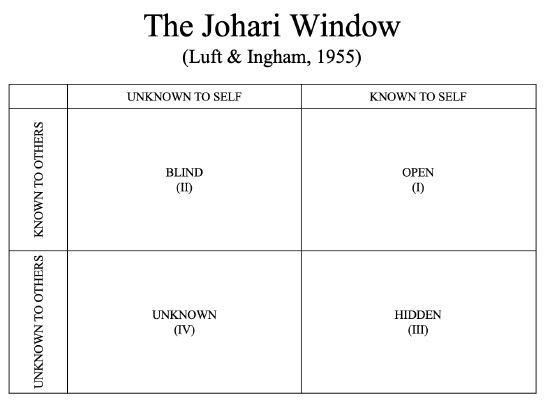
correlates with blindness/unknown personality elements (Johari Window)?
not knowing the self may lead to struggles in social connection, etc.
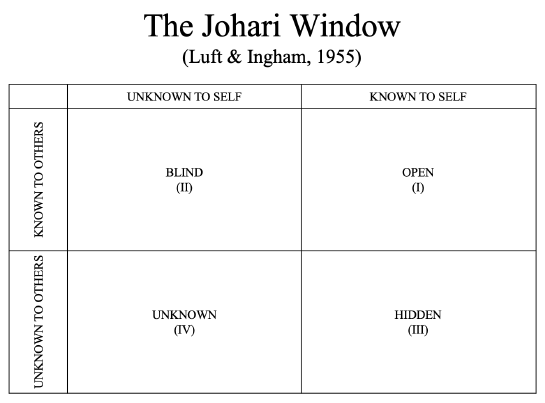
shortcomings of the original Johari Window?
it has been very difficult to actually decipher the accuracy of self-knowledge versus others’ knowledge of us because of methodological complications
Adapted Johari Window (Vazire & Mehl, 2008)
developed with the help of “the EAR”
V&M explored accuracy of self-perception + other’s perception
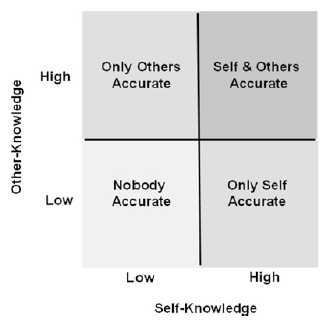
what are examples of EAR behaviours?
spend time by yourself
spend time with others
laughing
singing or whistling
crying
arguing/fighting
listening to music/radio
watching TV
reading
etc.
what problem did the EAR solve and how?
problem: lack of objective, unobtrusive measures of behaviour + there was minimal naturalistic observation in the field
i.e., there was no criterion independent of self- and other-rating that measures natural behaviour
solution: small, pocket-sized digital audio recorder with a lapel microphone
allows researchers to unobtrusively record a broad spectrum of acoustically detectable behaviors directly from people's daily lives
both objective and representative of their real-world behavior
what criterion measures do researchers testing the accuracy of self- and informant ratings traditionally rely on?
laboratory-based behaviour
self-reports of daily real-world behaviour
objective measures of (important) life outcomes
These 3 approaches reflect different solutions to the apparent trade-off between two goals:
using a criterion measure that is independent of self- and informant ratings
using an ecological criterion measure that captures a representative sample of targets’ behavior
why are studies of the relative predictive validity of self- and informant-ratings rare?
in part due to the methodological challenges involved with obtaining an appropriate criterion measure
these issues include
common (overlapping) method variance
ecological validity (representativeness)
example: has reference effect bias skewed self-report data?
culture
Americans report being more extroverted than Mexicans
when they used the EAR, comparing students in Texas versus Mexico, they replicated the self-reported phenomena of Americans saying they’re more extroverted but you find the opposite when you actually observed people (possibly due to reference effect)
gender roles
self-report suggests females are more talkative
EAR suggest there is no difference between genders
happy life
looked at correlations between conversation quality and quantity (self-report and EAR) + well-being
happier people seem to have more substantive conversations
substantive vs. small talk conversations even impact indicators of physical health (e.g., inflammatory markers)
reference effect
the idea that we tend to rate ourselves relative to those around us
how did Vazire & Mehl (2008) explore accuracy of self perceptions versus other perceptions?
study 1: lay predictions
Participants rated a list of behaviors on two separate scales:
how accurate they think people are at predicting how much they themselves perform each behavior
how accurate they think people are at predicting how much other people they know well perform this behavior.
study 2: actual behaviour
Participants provided self-reports and three additional informant reports of how frequently they engage in a list of behaviors
Participants then wore the EAR for four consecutive days during their waking hours
do people think self- or other-ratings are more accurate? (study 1; Vazire & Mehl, 2008)
people consider self-ratings consistently more accurate than-other ratings
actual self- or other-accuracy depends on the trait
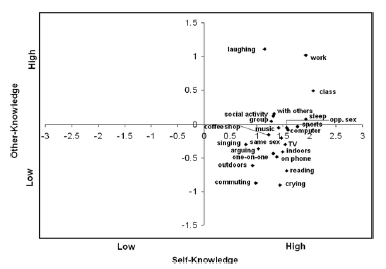
Do participants think that the two perspectives (self vs.
other) provide insight into different behaviors? (study2; Vazire & Mehl, 2008)
Lay perceptions about self- and other accuracy for most behaviors fell into the bottom right quadrant (known only to self), with a few falling into the top right quadrant.
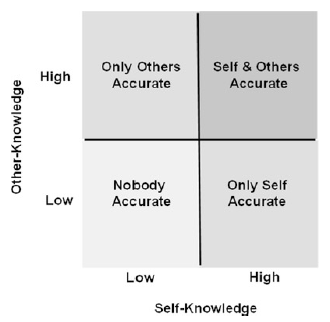
what is the relative accuracy and unique predictive validity of self- and other-ratings of daily behavior? (study 2; Vazire & Mehl, 2008)
The average accuracy across all 20 ACT behaviors was identical for the two perspectives (r = .26)
Self-accuracy was statistically significant for 13 of the 20 behaviors
Other-accuracy was statistically significant for 14 of the 20 behaviors
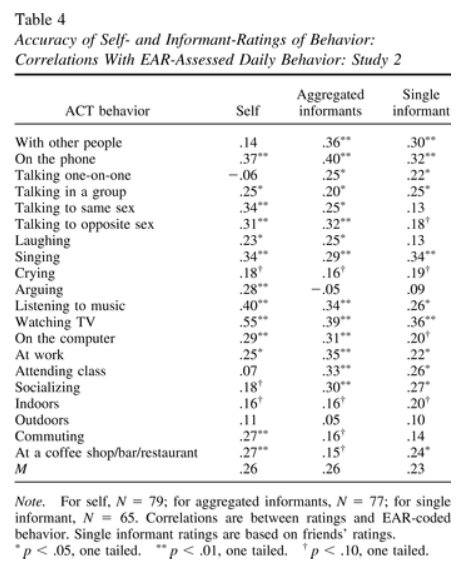
do the two perspectives provide unique insight? (study 2; Vazire & Mehl, 2008)
The accuracy correlations of self- and other-ratings ranged from 0 to .55 and covered all four quadrants of the Johari model.
This suggests that the two perspectives know about different behaviors.
though there were some commonalities
Self-ratings were significantly more accurate than for arguing, and were slightly but not significantly more accurate for watching TV.
Other-ratings were significantly more accurate for talking one-on-one, and attending a lecture, and were marginally significantly more accurate for spending time with others
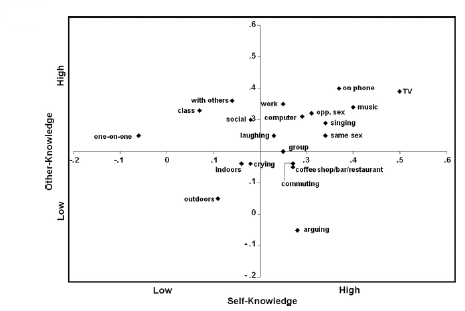
what were commonalities across self- and other-perspectives? (study 2; Vazire & Mehl, 2008)
accurate predicting
watching TV
talking on the phone
listening to music
inaccurate predicting
spending time indoors
spending time outdoors
crying
Knowing Me, Knowing You (Vazire & Mehl, 2008): result summary and implications
show that close others are as accurate as the self in predicting daily behavior
accuracy varies across behaviors for both the self and for others, and the two perspectives often independently predict behaviour
there is no perspective from which a person is known best
both the self and others possess unique insight into how a person typically behaves.
Self-Other Knowledge Asymmetry (SOKA) model
aims to provide a framework to explain and predict self-other asymmetries in accuracy
suggests that self vs. other-perception differs because of
informational differences in perspective (i.e., salience of overt vs. covert aspects of a person)
motivational significance (i.e., ego-relevance of the judgment)
what are the elements of the SOKA model?
human perceivers act as intuitive scientists
influenced by “cold” information-processing goals
helps us understand/predict other’s behaviour
human perceivers act as intuitive politicians
influenced by “hot” motivational goals
helps us protect/enhance self-worth
draws the conclusion that self-perception and other-perception differ due to differences in perspective (observability) and motivational (evaluativeness) significance
how might the quality and quantity of information influence self- and other-perceptions? (Vazire, 2010)
quantity
we have more information about the self
people place more weight on own-thought and feelings than behaviours when forming self-perceptions
quality
we have access to different types of information about the self vs. the other
salience of information differ, thus the information is detected and weighted differently
e.g., other-perceptions are more accurate for observable traits than for internal traits
SOKA model (Vazire, 2010): 2 predictions
Trait observability is associated with self-other
knowledge asymmetry such that others know more than the self about highly observable traits (e.g., extraversion) and the self knows more than others about traits low in observability (e.g., neuroticism).
However, low trait observability should be more consequential for strangers than for friends.
Trait evaluativeness is associated with self-other
knowledge asymmetry such that others know more than the self about highly evaluative traits (e.g., intellect), and this asymmetry is reduced or reversed for evaluatively neutral traits (e.g., extraversion or neuroticism).
People’s motives in judging a target are likely to influence what information they pay attention to (detection) and how they interpret that information (utilization).
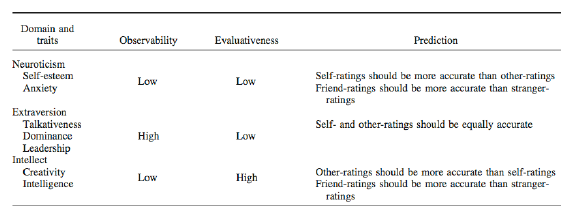
what is the main motivational difference between self-perception and other-perception?
the degree of ego-involvement
i.e., more concerned with protecting ego when doing self-ratings
how did Vazire (2010) test the validity of the SOKA model?
aim: SOKA model predicting which aspects of personality are best judged by the self and which are best judged by others
participant self-rating were rated by 4 friends and 4 strangers, specifically on
neuroticism
extraversion
intellect
SOKA model (Vazire, 2010): criterion measures
neuroticism: trier social stress test
talk about what you like and don’t like about your body
extraversion: leaderless group discussion
decide how to allocate fictional resources among yourselves
intelligence: wonderlic personnel test
12-min test of verbal and non-verbal intelligence
creativity: brick creativity test
list as many uses as you can for a brick
SOKA model (Vazire, 2010): results
the self knows more than others about neuroticism-related traits
friends know more than strangers about neuroticism-related traits
self and others know equal amounts about extraversion-related traits
friends know better than the self and stranger about intellect related traits

SOKA model (Vazire, 2010): implications
whether we know know ourselves or others know us better depends on the trait being evaluated
our biases may get in the way of our ability to judge the self (helps to explain self-esteem paradox)
self-esteem paradox
there’s often no obvious relationship between people’s accomplishments and virtues and their self-esteem
how accurate are self-perceptions? (Vazire & Carlson, 2010)
r = .25
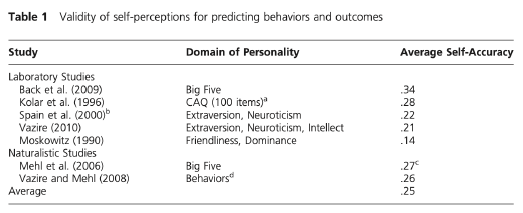
how accurate are other-perceptions? (Vazire & Carlson, 2010)
r = .40
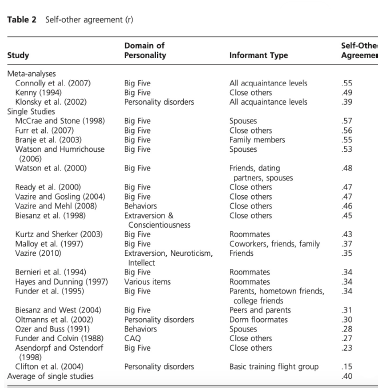
how accurate are personal assumptions about other-perceptions (i.e., meta-perceptions)? (Vazire & Carlson, 2010)
r = .44

meta-insight
Meta-perceptions predict others’ perceptions incrementally over self-perceptions, suggesting that people can distinguish between how they see themselves and how others see them
blind spots
there is considerable consensus among others’ perceptions even after controlling for targets’ self- and meta-perceptions, suggesting that others agree in their attribution of personality features to targets that the targets did not attribute to themselves or to their reputations